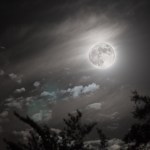The Moon
Posted to the homepage on August 11, 2013.
The Moon—like the sun, stars and Earth—is easy for a human being to take for granted. But the Earth's moon is truly exceptional, and should be appreciated for shaping the exceptional world we live on. Earth is the only planet with a single moon, and relative to the Earth, Luna is the largest moon in the solar system. The Moon thus exerts a strong, solitary influence on the planet it was torn from. Evidence suggests that the Moon was blown into orbit by a massive asteroid impact about 4.5 billion years ago, shortly before the…
Neil Armstrong, first man to walk (and take a photograph) on the Moon, died August 25th at the age of eighty-two. Armstrong and Buzz Aldrin turned a primordial fantasy into reality, and what we knew was possible changed in the space of a television broadcast. On Universe, Claire L. Evans honors the human spirit as explorer of the solar system, writing "Going to the moon has a tendency to turn test pilots into poets.” Now, with machines like Curiosity in the vanguard, we will have to wait a while for true Martian poetry. On Starts With a Bang, Ethan Siegel says that Armstrong's last act on…
The moon entrances us—it is near yet far away, familiar, yet unremittingly mysterious. In synchronous rotation, it has a face it never shows. It pulls the oceans; it stirs the blood. It beckons into the unknown. On Universe, Claire L. Evans says that in 1969, six artists snuck "a minuscule enamel wafer inscribed with six tiny drawings" onto Apollo 12's landing module. Claire writes, "the artistry of this 'museum' is as much about the gesture of sneaking it, illicitly, onto the leg of the lunar lander, as it is about the drawings themselves." On Starts With a Bang!, Ethan Siegel…
The science of cartography has come a long way over the centuries, from the caricatured coastlines of antiquity to the highly-detailed satellite images of today. We know our terrestrial boundaries very well, and until all the polar ice melts and raises sea levels, mapmakers are busy looking elsewhere. Greg Laden explores the magma chamber beneath Yellowstone, which was modelled by observing the transmission of shock waves through the earth's crust. Greg explains, "This sonar-like approach allows the mapping of underground three-dimensional structure," and he has the pictures to prove it…
